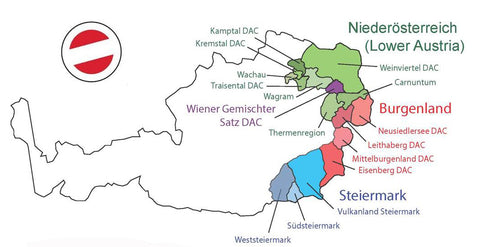Spotlight on Zweigelt & Terroir

While Austria will forever be revered by wine professionals for its spectacular, terroir-driven white wines, red wine production has progressively improved over the years, highlighting the versatility and dynamic nature of Austrian wine.
This post will explore Austria's most prominent red grape variety, Zweigelt, responsible for nearly 14% of Austria's total wine output and covering 6,400+ hectares under vine.
Zweigelt, also referred to as Blauer Zweigelt, Zweigeltrebe, or Rotburger, is a 20th century Austrian creation, one that has become fairly widespread in terms of vineyard plantings throughout the various growing regions.

Austrian Wine Map courtesy of Austrian Wine
Since the grape's inception, it has been propagated from the Weinviertel and the Kremstal all the way to the Burgenland and Thermenregion, where the grapes really thrive due to the warmer, Pannonian climate.
Zweigelt

On the other hand, Zweigelt, the offspring, is fairly straightforward and relatively easier to cultivate. Zweigelt grapes are typically one of the first red grape clusters to be snipped off the vines and brought into the cellars for processing, leaving ample time and consideration for later ripening, challenging varieties.


The structure and complexity of Zweigelt is dependent on the maturation of the wine, and specific characteristics of the grape can be enhanced by later harvest collections, fermentation and/or maturation in oak barriques, and extended skin contact macerations. While these techniques aid in the development of extract, color, and tannin structure, Austrian producers use them conservatively, showing precision and incredible restraint in terms of oak and extraction treatments.


In contrast, when Zweigelt undergoes some form of oak treatment, typically in the maturation phase of the wine life cycle, the wines gain a deeper, broader expression, with pronounced spicy aromatics. Often you can find notes of cacao and allspice, yielding a wine with chewy, compact tannins. These are wines destined for longer cellar maturation, and should be enjoyed 5-7 years post-bottling.
As previously mentioned in my blog post about Austrian red wine grape varieties, Zweigelt is incredibly versatile in the dining room, thanks to its rather 'chameleon' like character in the cellar. Some of my favorite pairings include tomato based dishes, like shakshouka, or more traditional Austrian dishes like tafelspitz.
Looking for more of a comfort food? Try the Johanneshof Reinisch Zweigelt with the Time Market Margherita Pizza, served with our house made fresh mozzarella.
The Zweigelt Scandal
While Zweigelt wines have gained international attention for their perfumed core of red fruits & peppery spice, the variety itself has earned itself quite a scandalous reputation, one that intertwines politics and history. For me, there is no other grape variety that bears such a scandalous past as Zweigelt, named after its infamous creator, Dr. Fritz Zweigelt.

As previously mentioned, Dr. Fritz Zweigelt was the Director of the School of Viticulture and Horticulture at Klosterneuburg, a prestigious monastery near Vienna. Over time, Dr. Zweigelt became a viticultural specialist, earning awards for his achievements in horticulture, viticulture and scientific discoveries. He was admired by countless grape breeders, scientists, and other academics, for his vigorous research and dedication to oenology.
In 1922, Dr. Zweigelt successfully crossed two varieties, Sankt Laurent and Blaufränkisch, ultimately developing the Zweigelt variety that we know of today. He penned the name 'Rotburger,' which was named in homage to Klosterneuburg (Rot-tr: red of Burger).
According to the academic investigative article by Dr. Daniel Decker entitled 'Wine in Austria : The History,' published on the website Austrian Wine, shortly after the creation of the grape in 1922, Europe witnessed the rise of Adolf Hitler, the 1938 annexation of Austria, and the subsequent onset of WWII.
Instead of excluding himself from the political stage, Dr. Zweigelt began wholly investing his time with the National Socialist German Workers' Party, otherwise known as the Nazi Party. His devout admiration for Hitler and the nationalist movement caused a schism amongst himself and his colleagues at Klosterneuburg, leading to his eventual academic demise.
During the war, he was not afraid to turn in students and staff members that were part of the resistance, as he saw them as an impetus to Austria's future. He was neither dismissed or reprimanded for doing so. Instead, Dr. Fritz Zweigelt continued to teach and educate at Klosterneuburg until the end of the war in 1945.
According to Dr. Daniel Decker, after the fall of the German reich, Dr. Zweigelt was brought to a detention camp, and was put on trial for treason and warmongering. Dr. Zweigelt was no longer allowed to work at Klosterneuburg, and lived out the rest of his life in Graz, Austria.
It was not until the 1950's when his former student and prominent viticulturist, Lenz Moser, championed for the grape to be named after its breeder, that the grape became permanently known as Zweigelt, or Blauer Zweigelt.
The name stuck.
Today, the name Zweigelt remains the OIV name, recognized worldwide as this important crossed variety. According to Daniel Decker, in the list of vine varieties managed by the International Organisation of Vine and Wine (OIV), Rotburger, Zweigeltrebe and Zweigelt are designated as synonyms for the Blauer Zweigelt variety, yet the majority of producers continue to use the name Zweigelt.
Zweigelt Conclusions

The acknowledgement of Dr. Zweigelt's history is important, and understanding the circumstances as to the grape's creation remains paramount.
For me, it is this intersection of history, politics, and wine that continues to excite my senses as a Sommelier and as a wine professional, leaving me utterly fascinated at how important grape growing is to politics and history.
And although we can identify and recognize the gravity of this 20th century scandal, it should in no way dissuade you from trying a Zweigelt wine. I merely mentioned the history because I found it interesting, and felt the need to share the inside scoop of this Austrian grape.

Zweigelt wines are delicious, exhibiting racy red-fruited characteristics, bright acidity, and a peppery finish. They are incredibly food friendly, and offer a lower alcohol, refreshing alternative for your summer red wine collection.

